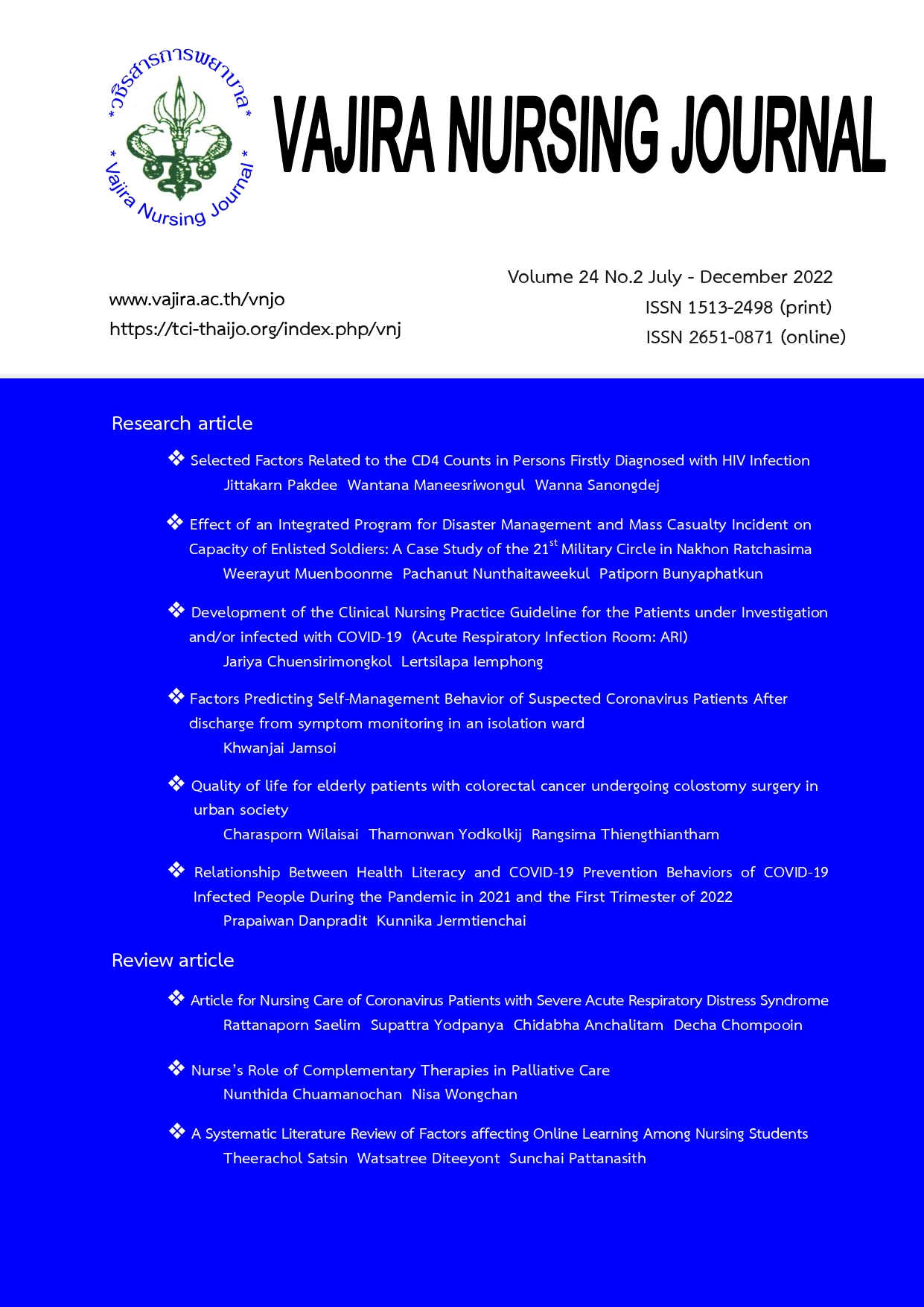คุณภาพชีวิตของผู้ป่วยสูงอายุโรคมะเร็งลำไส้ใหญ่ ที่ได้รับการผ่าตัดเปิดทวารใหม่ที่อาศัยในสังคมเขตเมือง
Main Article Content
บทคัดย่อ
งานวิจัยนี้เป็นการวิจัยเชิงสหสัมพันธ์ มีวัตถุประสงค์เพื่อศึกษาคุณภาพชีวิตของผู้ป่วยสูงอายุ โรคมะเร็งลำไส้ใหญ่ที่ได้รับการผ่าตัดเปิดทวารใหม่ที่อาศัยในสังคมเขตเมือง และเพื่อศึกษาความสัมพันธ์ ของปัจจัยที่มีผลต่อคุณภาพชีวิตของกลุ่มตัวอย่าง ที่แผนกผู้ป่วยนอก โรงพยาบาลวชิรพยาบาล โดยเลือกผู้เข้าร่วมวิจัยตามคุณสมบัติแบบเฉพาะเจาะจง จำนวน 65 ราย วิเคราะห์ข้อมูลด้วยสถิติเชิงพรรณนา และสัมประสิทธิ์สหสัมพันธ์ของเพียร์สัน ผลการวิจัยพบว่า คุณภาพชีวิตโดยรวมของผู้ป่วยวัยสูงอายุโรคมะเร็งลำไส้ใหญ่ที่มีทวารใหม่ในสังคมเขตเมืองอยู่ในระดับสูง ( = 5.42, SD = 1.36) โดยแบ่งออกเป็น คุณภาพชีวิตโดยรวมหลังการรักษา ( = 3.17, SD = 0.51) และคุณภาพชีวิตโดยรวมในช่วงสัปดาห์ที่ผ่านมา ( = 3.29, SD = 0.36) นอกจากนี้พบว่าคุณภาพชีวิตโดยรวมหลังการรักษามีความสัมพันธ์ทางบวกกับเจตคติการดูแลทวารใหม่ (r = 0.54, p < 0.01) และความรู้การดูแลทวารใหม่ (r = 0.28, p < 0.05) และยังพบว่าคุณภาพชีวิตโดยรวมในช่วงสัปดาห์ที่ผ่านมา มีความสัมพันธ์ทางบวกกับทักษะการดูแลทวารใหม่ (r = 0.26, p < 0.05) และเจตคติการดูแลทวารใหม่ (r = 0.38, p < 0.01) ในขณะที่แรงสนับสนุนทางสังคมไม่มีความสัมพันธ์กับคุณภาพชีวิตโดยรวมหลังการรักษา (r = 0.05, p < 0.05) และคุณภาพชีวิตในช่วงสัปดาห์ที่ผ่านมา (r = 0.03, p < 0.05)
Article Details

อนุญาตภายใต้เงื่อนไข Creative Commons Attribution-NonCommercial-NoDerivatives 4.0 International License.
เนื้อหาและข้อมูลในบทความที่ลงตีพิมพ์ในวชิรสารการพยาบาลถือเป็นข้อคิดเห็นและความรับผิดชอบของผู้เขียนบทความโดยตรง ซึ่งกองบรรณาธิการไม่จำเป็นต้องเห็นด้วย หรือร่วมรับผิดชอบใด ๆ ทั้งสิ้น
บทความ ข้อมูล เนื้อหา รูปภาพ ฯลฯ ที่ได้รับการตีพิมพ์ในวชิรสารการพยาบาล ถือเป็นลิขสิทธิ์ของวชิรสารการพยาบาล หากบุคคลใดหรือหน่วยงานใดต้องการนำทั้งหมดหรือส่วนหนึ่งส่วนใดไปเผยแพร่ต่อหรือเพื่อกระทำการใด ๆ จะต้องได้รับอนุญาตเป็นลายลักอักษรจากวชิรสารการพยาบาลก่อนเท่านั้น
เอกสารอ้างอิง
กรมกิจการผู้สูงอายุ. สถิติผู้สูงอายุ: สถานการณ์และแนวโน้มสังคมผู้สูงอายุไทย พ.ศ.2556-2573.2564. Retrieved from www.dop.go.th/ th/know/side/1/1/47
ชวนันท์ สุมนะเศรษฐกุล.การนิยามและพัฒนาระบบงานด้านเวชศาสตร์เขตเมือง.วชิรเวชสารและวารสารเวชศาสตร์เขตเมือง.2563; 64(2): 159-164.
Institute of population and social research. 2013. Retrieved from https://link.springer.com/ article/10.1007/s40737-020-00211-7
วีรวุฒิ อิ่มสำราญ, อาคม ชัยวีระวัฒนะ, สมชาย ธนะสิทธิชัย, ปิยวัฒน์ เลาวหุตานนท์, และ ศุลีพร แสงกระจ่าง. โรคมะเร็ง (Cancer). กรุงเทพมหานคร: การแพทย์ไทย.2558.
National Comprehensive Cancer Network. NCCN QUICK GUIDE™ for Colon Cancer. 2018. Retrieved from https://www.nccn.org/ patients/ guidelines/content/PDF/nccnquickguide- colon-patient.pdf.https://www.nccn.org/ patients/guidelines/content/PDF/nccnquickguide-colon-patient.pdf
สถาบันมะเร็งแห่งชาติ.ทะเบียนมะเร็งระดับโรงพยาบาล พ.ศ.2562. ประเทศไทย: กรมการแพทย์ กระทรวสาธารณสุข.2562.
คณะแพทยศาสตร์วชิรพยาบาล. สถิติการปฏิบัติงาน คณะแพทยศาสตร์วชิรพยาบาล มหาวิทยาลัยนวมินทราธิราช ปีงบประมาณ 2556. กรุงเทพฯ: งานเวชสถิติ สำนักงานผู้อำนวยการโรงพยาบาลวชิรพยาบาล. 2553.
Hongtiyanon, T., & Tipawong, A. Relationships between Social Support and Quality of Life in Schizophrenia Patients. วารสารพยาบาลทหารบก. 2561;19(Supplement): 487- 494.
Singh, J. A. Chapter 11 - Quality of Life. In N. Schlesinger & P. E. Lipsky (Eds.), Gout. Elsevier. 2019;119-139.
McGee, H. M. Chronic Illness: Quality of Life. In N. J. Smelser & P. B. Baltes (Eds.).
InternationalEncyclopedia of the Social & Behavioral Sciences. Oxford: Pergamon. 2001;1779-1782.
Siripitayakunkit, A. Social Support: An Important Factor to Care for Persons with Diabetes Mellitus. Rama Nursing Journal. 2010; 16(2): 309-322.
World Health Organization. WHOQOL: Measuring Quality of Life. 2020. Retrieved from https://www.who.int/tools/whoqol.
วิกิตำรา. ความรู้เรื่องประชากรและชุมชนเมือง. 2562. Retrieved from https://th.wikibooks.org/ wiki.
คณะแพทยศาสตร์วชิรพยาบาล. รายงานประจำปี 2020 คณะแพทยศาสตร์วชิรพยาบาล มหาวิทยาลัยนวมินทราธิราช. 2563.
รัตน์ศิริ ทาโต. การวิจัยทางพยาบาลศาสตร์:แนวคิดสู่การประยุกต์ใช้ (ฉบับปรับปรุง). โรงพิมพ์แห่งจุฬาลงกรณ์มหาวิทยาลัย: กรุงเทพฯ.2561.
ณัฐรมย์ ชุติกาโม รุ้งระวี นาวีเจริญ และวรุตม์ โล่สิริวัฒน์. ปัจจัยทำนายคุณภาพชีวิตของผู้ป่วยวัยผู้ใหญ่ โรคมะเร็งลำไส้ใหญ่ และทวารหนักที่มีทวารเทียม.วารสารแพทย์นาวี. 2561; 44(3):103-116.
จรัสพร วิลัยสัย สุชิรา ชัยวิบูลย์ธรรม และปิยะวรรณ โภคพลากรณ์.ผลของโปรแกรมส่งเสริมศักยภาพของผู้ดูแล ต่อความรู้ ทักษะการดูแลทวารใหม่ และภาวะแทรกซ้อน.วารสารเกื้อการุณย์. 2564; 28(2): 48-63.
Abdelmohsen, S. Effectiveness of Structured Education on Patient Knowledge and Practice Regarding Colostomy Care. Asia-Pacific Journal of Oncology Nursing. 2020; 7(4): 370-374.doi: 10.4103/apjon.apjon_24_20
สุจินดา ลดาสุนทร นิโลบล กนกสุนทรรัตน์ และ สุชิรา ชัยวิบูลย์ธรรม. ผลของโปรแกรมการสื่อวีดิทัศน์ช่วยสอนต่อความรู้ และทักษะการดูแลทวารเทียมในญาติผู้ดูแลผู้มีทวารเทียมรายใหม่. รามาธิบดีพยาบาลสาร. 2562;25(1): 43-57.
Rajendran S. Assess the Knowledge, Attitude and Practice on Ostomy Care Among Ostomates Attending Stoma Clinic. 2016.
นวพรรษ สีมารักษ์ ศิริลักษณ์ กิจศรี ไพศาล และ ณัฏฐนันท์ พรสงวนกลิ่น. ความสัมพันธ์ระหว่างความ หวัง การสนับสนุนทางสังคม ความทุกข์ทรมานจากอาการ และ คุณภาพชีวิตของผู้ป่วยมะเร็งลำไส้ใหญ่ และ ทวารหนักที่ได้รับยาเคมีบำบัด.วารสารพยาบาลตำรวจ. 2561; 10(1):61-70.
Hong, K. S., Oh, B. Y., Kim, E. J., Chung, S. S., Kim, K. H., & Lee, R. A. Psychological attitude to self-appraisal of stoma patients: prospective observation of stoma duration effect to self-appraisal. Annals of surgical treatment and research. 2014; 86(3):152–160. https://doi.org/10.4174/astr.2014. 86.3.152
นวพรรษ สีมารักษ์ ศิริลักษณ์ กิจศรี ไพศาล และ ณัฏฐนันท์ พรสงวนกลิ่น. ความสัมพันธ์ระหว่างความ หวัง การสนับสนุนทางสังคม ความทุกข์ทรมานจากอาการ และ คุณภาพชีวิตของผู้ป่วยมะเร็งลำไส้ใหญ่ และ ทวารหนักที่ได้รับยาเคมีบำบัด.วารสารพยาบาลตำรวจ. 2561; 10(1):61-70.
เสาวรส ฉันทธรรมสกุล ชุลีกร ด่านยุทธศิลป์ ปกรณ์ ประจัญบาน และสาวิตรี ตันเจริญ.การเปรียบเทียบคุณภาพชีวิตของผู้สูงอายุที่อาศัยอยู่ในเขตชุมชนเมืองกับชุมชนชนบทพื้นที่อำเภอเมืองพิจิตร จังหวัดพิจิตร. วารสารการพยาบาลและสุขภาพ. 2556;7(1):90-101.


